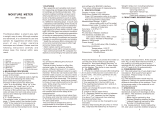
MO270-en-GB_v2.4 8/16
17
Appendix – Wood Groups
Building materials – Group 1 – drywall, sheetrock, etc.
Common names of timbers (BS888 & 589:1973) with MO270 program group numbers
Abura 4 Gurjun 1 Pine,AmericanLongLeaf 3
Afara 1 Hemlock,Western 3 Pine,AmericanPitch 3
Aformosa 6 Hiba 8 Pine,Bunya 2
Afzelia 4 Hickory 5 Pine,CaribbeanPitch 3
Agba 8 Hyedunani 2 Pine,Corsican 3
Amboyna 6 Iroko 5 Pine,Hoop 3
Ash,American 2 Ironbank 2 Pine,Huon 2
Ash,European 1 Jarrah 3 Pine,JapaneseBlack 2
Ash,Japanese 1 Jelutong 3 Pine,Kauri 4
Ayan 3 Kapur 1 Pine,Lodgepole 1
Baguacu,Brazilian 5 Karri 1 Pine,Maritime 2
Balsa 1 Kauri,NewZealand 4 Pine,NewZealandWhite 2
BangaWanga 1 Kauri,Queensland 8 Pine,NicaraguanPitch 3
Basswood 6 Keruing 5 Pine,Parana 2
Beech,European 3 Kuroka 1 Pine,Ponderosa 3
Berlina 2 Larch,European 3 Pine,Radiata 3
Binvang 4 Larch,Japanese 3 Pine,Red 2
Birch,European 8 Larch,Western 5 Pine,Scots 1
Birch,Yellow 1 Lime 4 Pine,Sugar 3
Bisselon 4 Loliondo 3 Pine,Yellow 1
Bitterwood 5 Mahogany,African 8 Poplar,Black 1
Blackbutt 3 Mahogany,WestIndian 2 Pterygota,African 1
Bosquiea 1 Makore 2 Pyinkado 4
Boxwood,Maracaibo 1 Mansonia 2 QueenslandKauri 8
Camphorwood,EAfrican 3 Maple,Pacific 1 QueenslandWalnut 3
Canarium,African 2 Maple,Queensland 2 Ramin 6
Cedar,Japanese 2 Maple,Rock 1 Redwood,Baltic(European) 1
Cedar,WestIndian 8 Maple,Sugar 1 Redwood,Californian 2
Cedar,WesternRed 3 Matai 4 Rosewood,Indian 1
Cherry,European 8 Meranti,Red(dark/light) 2 Rubberwood 7
Chestnut 3 Meranti,White 2 SantaMaria 7
Coachwood 6 Merbau 2 Sapele 3
Cordia,AmericanLight 5 Missanda 3 Sen 1





















